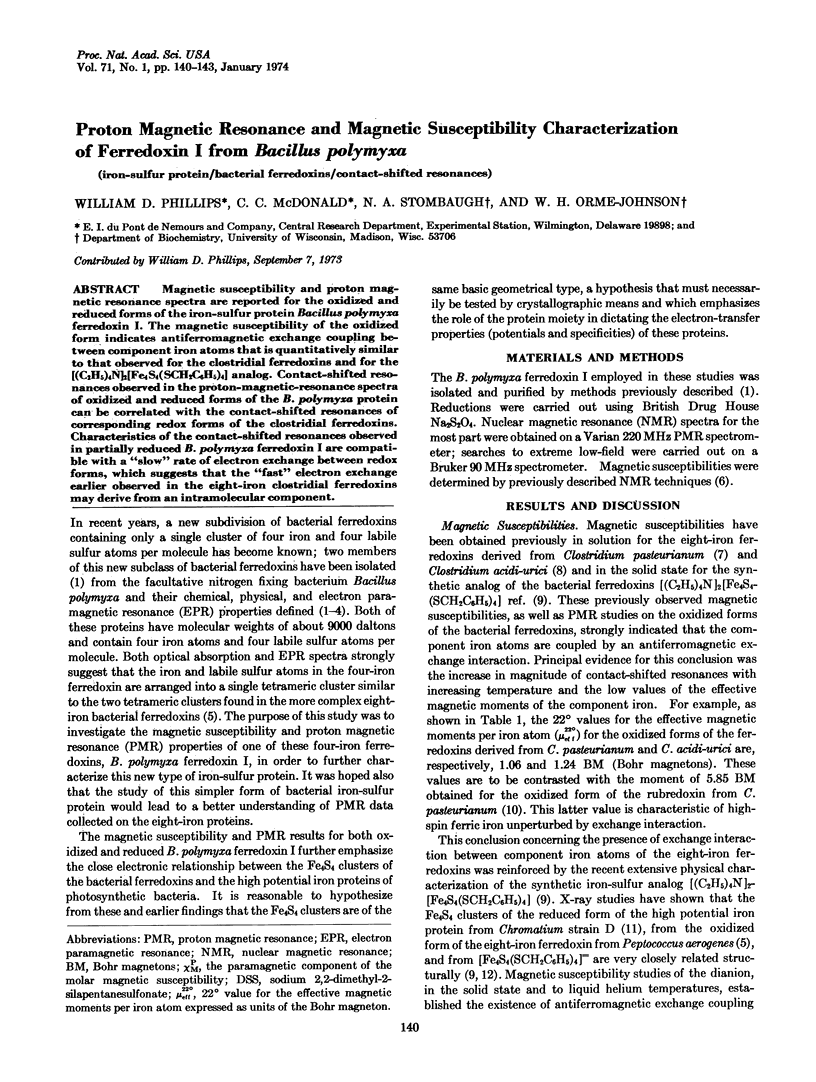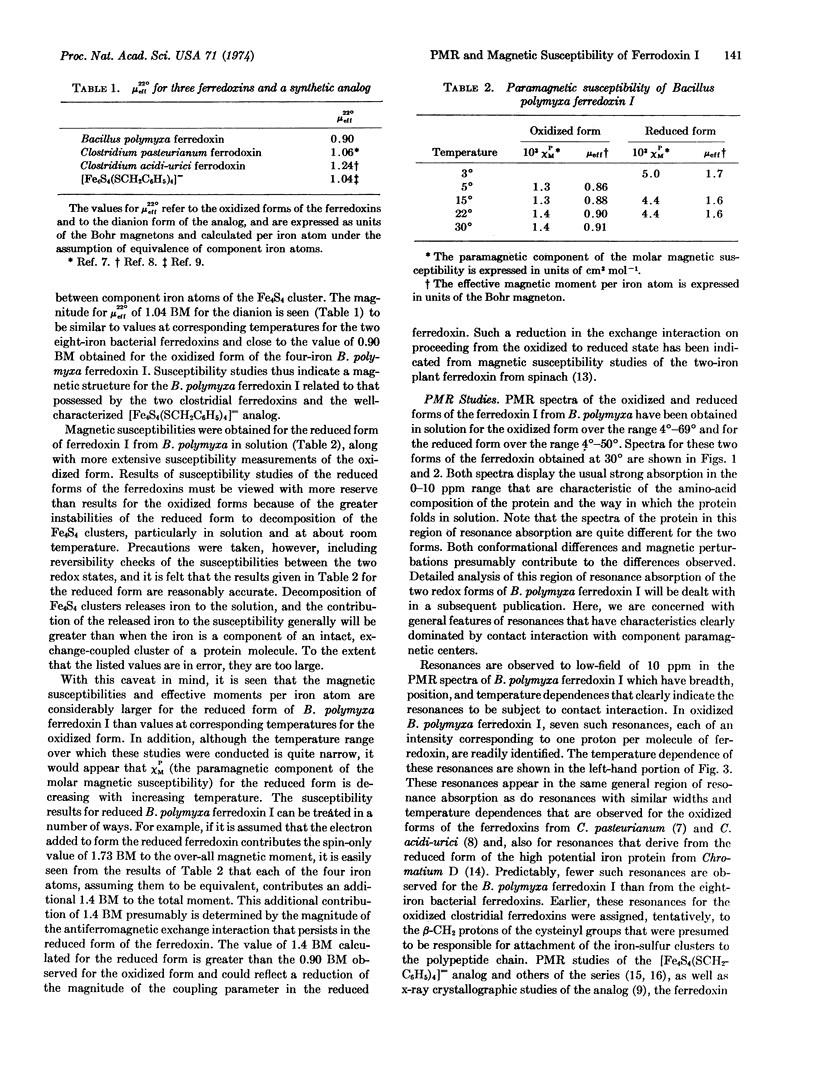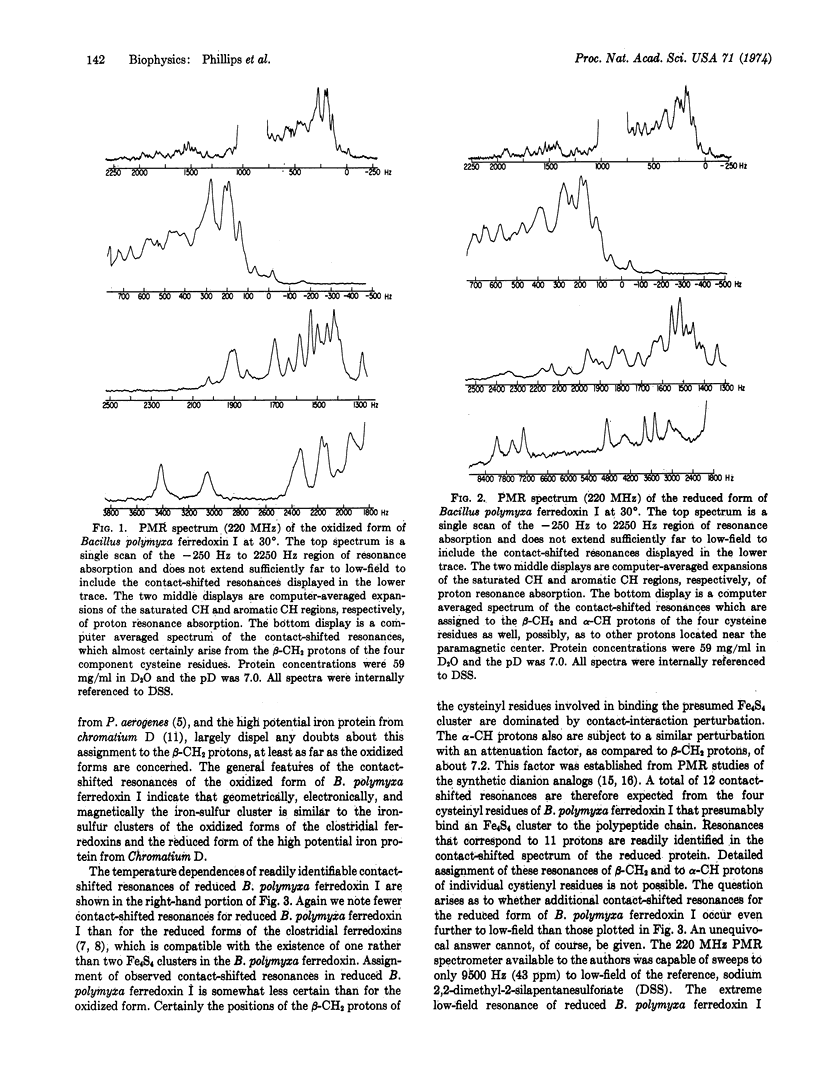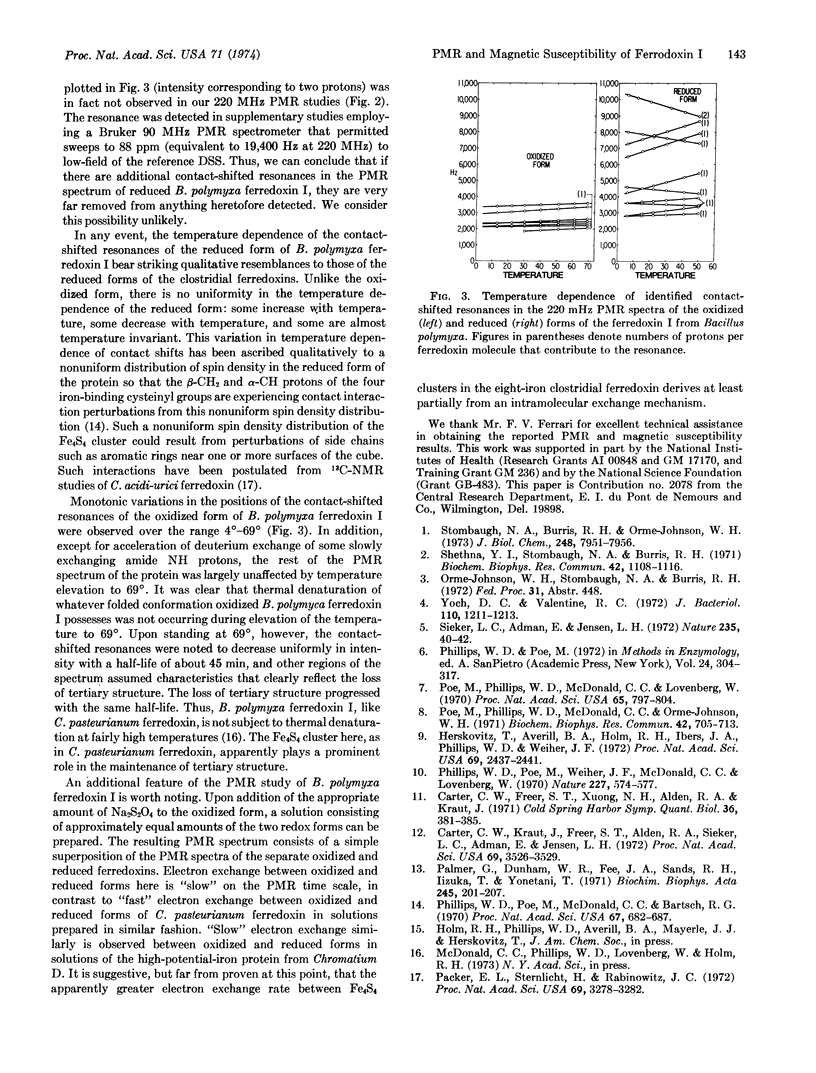Abstract
Magnetic susceptibility and proton magnetic resonance spectra are reported for the oxidized and reduced forms of the iron-sulfur protein Bacillus polymyxa ferredoxin I. The magnetic susceptibility of the oxidized form indicates antiferromagnetic exchange coupling between component iron atoms that is quantitatively similar to that observed for the clostridial ferredoxins and for the [(C2H5)4N]2 [Fe4S4(SCH2C6H5)4] analog. Contact-shifted resonances observed in the proton-magnetic-resonance spectra of oxidized and reduced forms of the B. polymyxa protein can be correlated with the contact-shifted resonances of corresponding redox forms of the clostridial ferredoxins. Characteristics of the contact-shifted resonances observed in partially reduced B. polymyxa ferredoxin I are compatible with a “slow” rate of electron exchange between redox forms, which suggests that the “fast” electron exchange earlier observed in the eight-iron clostridial ferredoxins may derive from an intramolecular component.
Keywords: iron-sulfur protein, bacterial ferredoxins, contact-shifted resonances
Full text
PDF



Selected References
These references are in PubMed. This may not be the complete list of references from this article.
- Carter C. W., Jr, Freer S. T., Xuong N. H., Alden R. A., Kraut J. Structure of the iron-sulfur cluster in the Chromatius iron protein at 2.25 Angstrom resolution. Cold Spring Harb Symp Quant Biol. 1972;36:381–385. doi: 10.1101/sqb.1972.036.01.049. [DOI] [PubMed] [Google Scholar]
- Carter C. W., Jr, Kraut J., Freer S. T., Alden R. A., Sieker L. C., Adman E., Jensen L. H. A comparison of Fe 4 S 4 clusters in high-potential iron protein and in ferredoxin. Proc Natl Acad Sci U S A. 1972 Dec;69(12):3526–3529. doi: 10.1073/pnas.69.12.3526. [DOI] [PMC free article] [PubMed] [Google Scholar]
- Herskovitz T., Averill B. A., Holm R. H., Ibers J. A., Phillips W. D., Weiher J. F. Structure and properties of a synthetic analogue of bacterial iron--sulfur proteins. Proc Natl Acad Sci U S A. 1972 Sep;69(9):2437–2441. doi: 10.1073/pnas.69.9.2437. [DOI] [PMC free article] [PubMed] [Google Scholar]
- Packer E. L., Sternlicht H., Rabinowitz J. C. The possible role of aromatic residues of Clostridium acidi-urici ferredoxin in electron transport. Proc Natl Acad Sci U S A. 1972 Nov;69(11):3278–3282. doi: 10.1073/pnas.69.11.3278. [DOI] [PMC free article] [PubMed] [Google Scholar]
- Palmer G., Dunham W. R., Fee J. A., Sands R. H., Iizuka T., Yonetani T. The magnetic susceptibility of spinach ferredoxin from 77-250 degrees K: a measurement of the antiferromagnetic coupling between the two iron atoms. Biochim Biophys Acta. 1971 Aug 6;245(1):201–207. doi: 10.1016/0005-2728(71)90022-3. [DOI] [PubMed] [Google Scholar]
- Phillips W. D., Poe M. Contact shifts and magnetic susceptibilities in iron-sulfur proteins as determined from nuclear magnetic resonance spectra. Methods Enzymol. 1972;24:304–317. doi: 10.1016/0076-6879(72)24077-0. [DOI] [PubMed] [Google Scholar]
- Phillips W. D., Poe M., McDonald C. C., Bartsch R. G. Proton magnetic resonance studies of Chromatium high-potential iron protein. Proc Natl Acad Sci U S A. 1970 Oct;67(2):682–687. doi: 10.1073/pnas.67.2.682. [DOI] [PMC free article] [PubMed] [Google Scholar]
- Phillips W. D., Poe M., Weiher J. F., McDonald C. C., Lovenberg W. Proton magnetic resonance, magnetic susceptibility and Mössbauer studies of Clostridium pasteurianum rubredoxin. Nature. 1970 Aug 8;227(5258):574–577. doi: 10.1038/227574a0. [DOI] [PubMed] [Google Scholar]
- Poe M., Phillips W. D., McDonald C. C., Lovenberg W. Proton magnetic resonance study of ferredoxin from Clostridium pasteurianum. Proc Natl Acad Sci U S A. 1970 Apr;65(4):797–804. doi: 10.1073/pnas.65.4.797. [DOI] [PMC free article] [PubMed] [Google Scholar]
- Poe M., Phillips W. D., McDonald C. C., Orme-Johnson W. H. PMR and magnetic susceptibility studies on Clostridium acidi-urici ferredoxin. Biochem Biophys Res Commun. 1971 Feb 19;42(4):705–713. doi: 10.1016/0006-291x(71)90545-6. [DOI] [PubMed] [Google Scholar]
- Shethna Y. I., Stombaugh N. A., Burris R. H. Ferredoxin from Bacillus polymyxa. Biochem Biophys Res Commun. 1971 Mar 19;42(6):1108–1116. doi: 10.1016/0006-291x(71)90019-2. [DOI] [PubMed] [Google Scholar]
- Sieker L. C., Adman E., Jensen L. H. Structure of the Fe-S complex in a bacterial ferredoxin. Nature. 1972 Jan 7;235(5332):40–42. doi: 10.1038/235040a0. [DOI] [PubMed] [Google Scholar]
- Strombaugh N. A., Burris R. H., Orme-Johnson W. H. Ferredoxins from Bacillus polymyxa. Low potential iron-sulfur proteins which appear to contain single four iron, four sulfur centers accepting a single electron on reduction. J Biol Chem. 1973 Nov 25;248(22):7951–7956. [PubMed] [Google Scholar]
- Yoch D. C., Valentine R. C. Four-iron (sulfide) ferredoxin from Bacillus polymyxa. J Bacteriol. 1972 Jun;110(3):1211–1213. doi: 10.1128/jb.110.3.1211-1213.1972. [DOI] [PMC free article] [PubMed] [Google Scholar]


